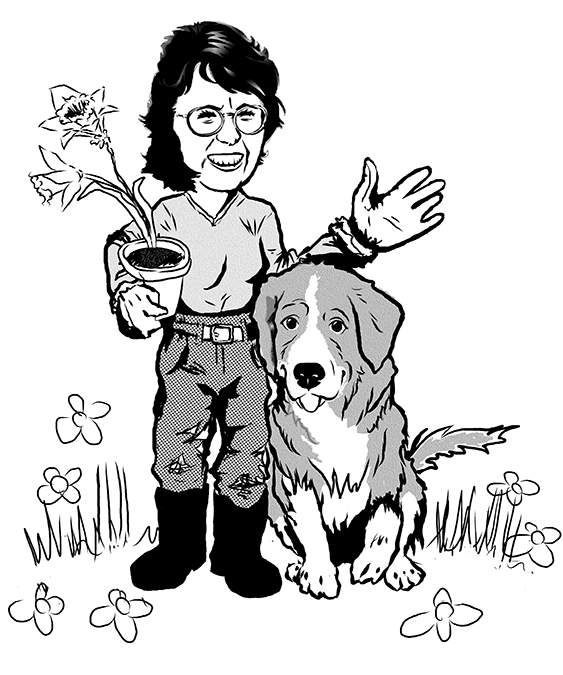by Leslie Cox; Saturday; February 10, 2018
 Sun! And it happened on a day with no appointments, meetings, contractors, volunteer duties, or town errands. Something that has not happened in this house for quite some weeks now. What a treat!
Sun! And it happened on a day with no appointments, meetings, contractors, volunteer duties, or town errands. Something that has not happened in this house for quite some weeks now. What a treat!
Of course, this does not mean we took a leisurely hike with Sadie…well, we did go the beach for our daily walk…or sat on the porch soaking up the rays. Nope. Dug out all the pruning tools, including the chainsaw and got to work on some serious pruning. John tackled our huge grape while I got to work on some much needed remedial hacking on my over-large Rhododendron macropyllum, (Pacific rhododendron).
 This native rhodo does not seem to know any boundaries. While its initial roots are on our side of the fence, it has spread out to the edge of the road allowance in one direction and through the fence into the neighbour’s yard where it is threatening to encroach onto their driveway. So far, they have managed to keep it at bay. (That is the rhodo behind John. The main plant is to the left of the wheelbarrow tucked underneath the ornamental plum tree.)
This native rhodo does not seem to know any boundaries. While its initial roots are on our side of the fence, it has spread out to the edge of the road allowance in one direction and through the fence into the neighbour’s yard where it is threatening to encroach onto their driveway. So far, they have managed to keep it at bay. (That is the rhodo behind John. The main plant is to the left of the wheelbarrow tucked underneath the ornamental plum tree.)
But enough is enough and this is the year I resolved to bring this native back under some form of control. Not sure how far I can actually go in pruning this huge rhodo back, however, because I do not want to damage its growth on the neighbour’s side. Mind you, it would behoove me to talk to my neighbours as they may prefer to have the rhodo reined in on their side too.
After spending about an hour on the rhodo, I have only made an inroad into the pruning work still to be done. It is definitely a big project!
 On to other pruning…I am sad to say, my Cornus nuttallii (Pacific dogwood) has been chopped down. (Hence the chainsaw.) This tree has been struggling with a virulent anthracnose species since 2014. Unfortunately, this disease is spreading throughout the Pacific Northwest and it is decimating the dogwoods in the wild. Not a good scenario for the provincial flower of BC…especially as there is no cure for anthracnose.
On to other pruning…I am sad to say, my Cornus nuttallii (Pacific dogwood) has been chopped down. (Hence the chainsaw.) This tree has been struggling with a virulent anthracnose species since 2014. Unfortunately, this disease is spreading throughout the Pacific Northwest and it is decimating the dogwoods in the wild. Not a good scenario for the provincial flower of BC…especially as there is no cure for anthracnose.
 It is always hard to take out a tree, given the time invested into growing it to a representative size. We planted my dogwood sapling in the spring of 1999 when we both lost our jobs. It was a reminder of the dogwoods lining the Gold River/Campbell River highway which we traveled frequently. This young sapling was also our symbol of starting a new chapter in our lives by embarking in a new career direction…leaving corporations behind to start a garden and become entrepreneurs. Needless to say, the wounds bit deep as we cut the dogwood down.
It is always hard to take out a tree, given the time invested into growing it to a representative size. We planted my dogwood sapling in the spring of 1999 when we both lost our jobs. It was a reminder of the dogwoods lining the Gold River/Campbell River highway which we traveled frequently. This young sapling was also our symbol of starting a new chapter in our lives by embarking in a new career direction…leaving corporations behind to start a garden and become entrepreneurs. Needless to say, the wounds bit deep as we cut the dogwood down.
However, this is what happens in a garden. All plants die eventually…whether from age or disease…to make way for new growth. And even now, there is growth happening in some areas of the garden.
I spotted a small clump of snowdrops (Galanthus nivalis) under my beauty bush (Kolkwitzia amabilis) as I was pruning out some of the older branches. What a joy to see the white flower buds almost ready to open.
Also in bloom right now are the Eranthis hyemalis, or winter aconite. I suspect they have actually been blooming for close to two weeks now and I had not noticed. They are not on my usual flight path to the compost bins and I have been too busy with contractors and volunteer duties to take my regular walkabouts through the garden. This would also explain why I had not noticed the barest of green tips showing in the garlic patch as of a week or so ago.
I need to seriously address my priority list from here on in! Taking my regular garden walks to see what is sprouting in the garden is my go-to tonic to combat the dregs of a long winter.


